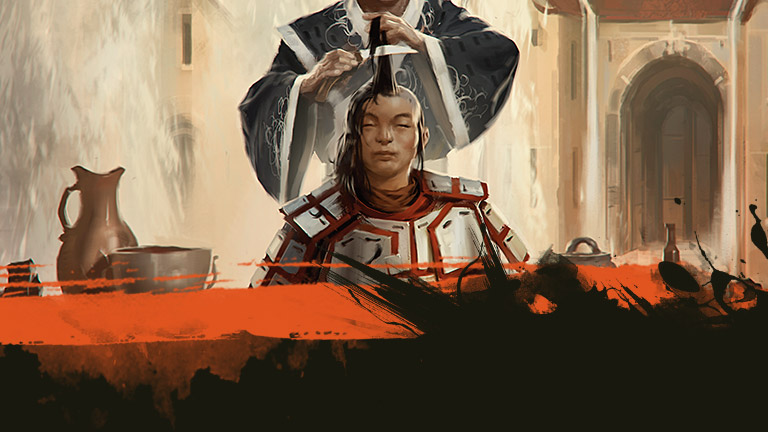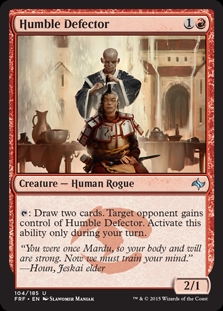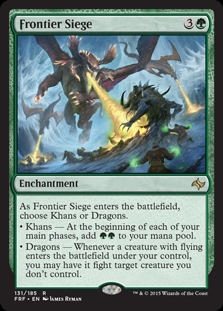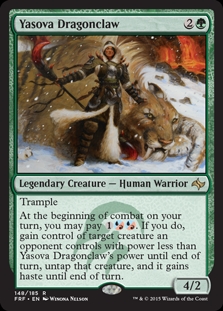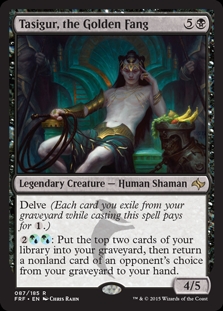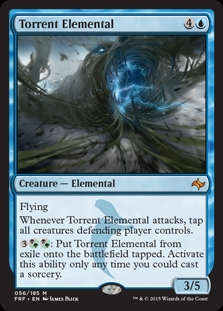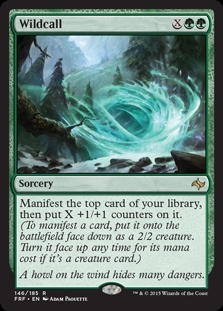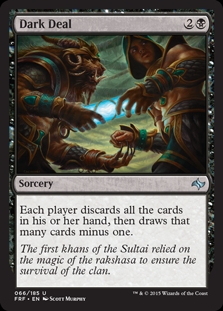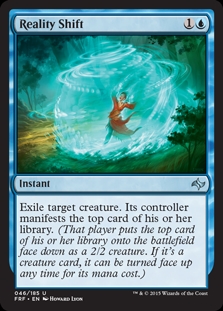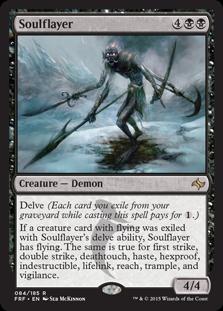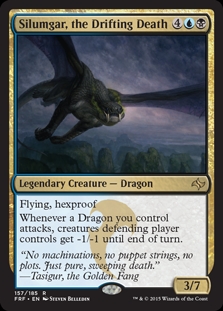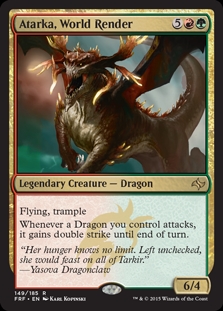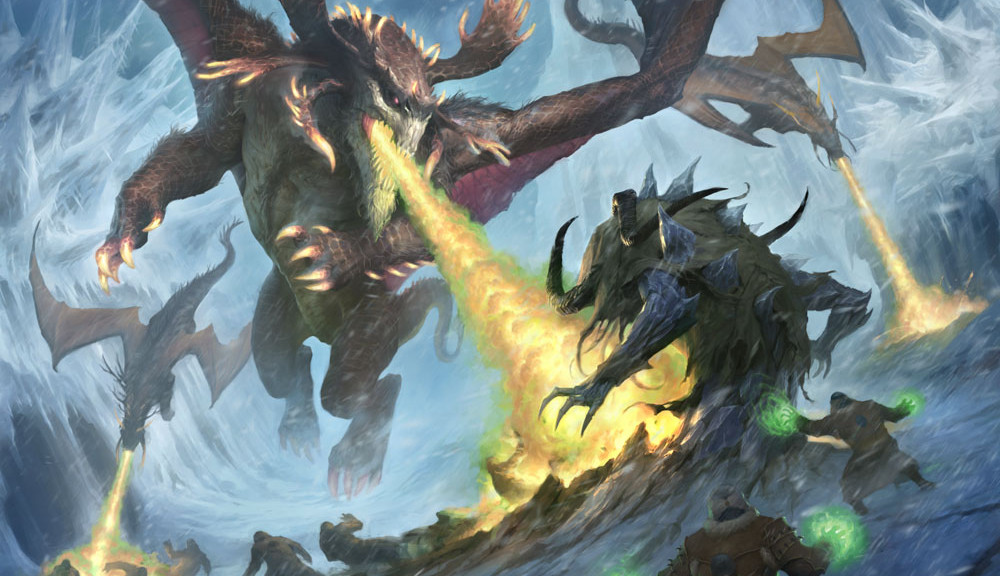By: Travis Allen
We can all pretty much agree that Wizards hit Khans of Tarkir out of the park. Before packs even hit the shelves players were excited about the return of fetchlands, opening the door for many players to Modern. Once the cardboard was in sleeves it turned out that Khans was even better than expected. Standard has been robust and skill-intensive since basically week one, with the top decks changing every weekend. Not only is there no de facto best deck, players are free to pick up nearly any strategy they like and as long as it’s coherent, they’re capable of posting solid results. Between the fetches, a Standard format that rewards both grinders and brewers, and a bucket of eternal cards including honest-to-God Ancestral Recall, Khans of Tarkir will be remembered as one of the best fall sets in the NWO.
Fate Reforged has a lot to live up to, but early press is that it does a damn good job. Only a single card really stands out as unquestionably powerful and format-changing, while the entire rest of the set is full of conditionally strong cards that will reward careful deck building and studied application. It seems like FRF will have ripple effects in many decks in many formats, but for the most part won’t dramatically alter anything. (Except Monastery Mentor.)
It’s important to remember when reading any set review that we are forced to evaluate cards in a pseudo-vacuum, but they never exist as such. When I look at Brimaz, King of Oreskos I have to consider the card individually, free of whatever the metagame looks like that particular month. Brimaz’s text box isn’t going to change, but the cards other people are playing will. I need to focus on what concrete information I have available to me. Because of this, set reviews are especially challenging. I have to look at Brimaz and make an evaluation based strictly on the words printed on the card, but his true worth will be dependent on the cards around him, a pool that will change significantly over time. Cards that are excellent right now may have been trash in an alternate timeline. It would be easy to construct a Standard environment where Desecration Demon is crap (such as he was in INN-RTR when Lingering Souls was legal,) or where Prime Speaker Zegana is a chase mythic. Even the hallowedJace, the Mind Sculptor was nigh unplayable at release since there wasn’t a single other playable blue card in the format andBloodbraid Elf + Blightning threatened to shut him down as soon as he resolved.
With that in mind, FRF is the toughest set I’ve ever reviewed. The complexity level is through the roof. Text boxes on everything from mythics to commons are packed this time through, and even cards that aren’t wordy, like Humble Defector, have the ability to spawn entire new decks. Delve was difficult to understand in Khans and will continue to be tricky to evaluate here, and Manifest could land anywhere between “Chroma” and “Devotion.” Never before have I listed so many cards in the bulk section while wondering if it’s actually a $7 card. Those of you reading this with the luxury of hindsight, please be kind to me. That said, let’s jump in!
Prices listed are where I expect the card to be one month from now, and at the release of Dragons of Tarkir.
White
Bulk
Citadel Siege
Daghatar the Adamant
Dragonscale General
Mastery of the Unseen
Rally the Ancestors
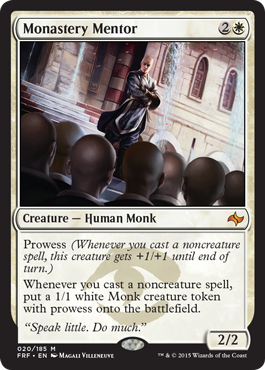
Monastery Mentor
1 Month: $23-$35
Dragons of Tarkir: $20-$30
The screams you hear in the streets are from people being bludgeoned to death by Wizards employees wielding wooden clubs with “Monastery Mentor is good” primitively etched into them.
Monastery Mentor is quite clearly going to be a Standard pillar, and probably also a role-player in both Modern and Legacy. It’s not surprising when you consider the damage output on this guy. A Mentor on turn three leads to a turn five kill in several different ways, and orchestrating a turn six kill is trivial. That’s potentially as fast as Pack Rat, and faster than Goblin Rabblemaster. Before I get too far down this path though, I’ll just point you in the direction of Chapin. Many will discuss the quality of the card, so I’ll focus on what to expect price-wise.
We can be damn near positive this is going to be one of the absolute best cards in Standard, and will typically show up as a full playset in any deck that runs it. Our best approximation is Goblin Rabblemaster, a rare, which was over $20 at his peak and is still $15 today. If Mentor sees play in Standard exactly as Rabblemaster has with zero play in additional formats, the price would easily hang at $20 or more. Once you start adding additional demand, the price rises with it.
While Rabblemaster gives us a great profile of what to expect in Standard, we need only look back a single core set to find another similar threat for larger formats. Young Pyromancer is one of the best two-drop threats in Modern and Legacy, resulting in a $3 uncommon (and $40 foil) whose demand is solely those two formats. Mentor isn’t the same card as YP, and at a higher cost won’t necessarily land in the same decks, but I have no doubt he’ll break into both formats in much the same way. Not only does he easily slot in alongside YP in many of the same lists, he is a more robust stand-alone threat than YP is. A single YP may be capable of winning a game, but a single Mentor will do it faster and more reliably, even though he comes down a full turn later.
I will be surprised if Mentor finds himself much below $20 at any point he’s Standard legal, and I don’t think it’s unrealistic that he’s usually in the $25-$30 range, with prices yet higher than that possible if many of the other cards in Fate Reforged don’t pan out.
Mentor is expensive, but if you want to play with him, don’t feel bad about just ordering a set. You don’t stand to lose much at all, and even if he drops to $20 a copy, your loss is small relative to the overall cost of the playset.
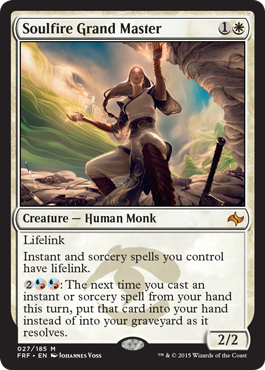
Soulfire Grand Master
1 Month: $15-$20
Dragons of Tarkir: $7-$15
White may only have two cards worth talking about this set, but they sure are powerful.
By now you’ve probably read a lot about how good Soulfire may or may not be from people better qualified to do that sort of thing. Rather than rehash what they’ve discussed, I’ll keep to strict money chat.
Soulfire is a splashy card with a several moving parts that are not often seen in Magic. Giving your spells lifelink has happened before, as has rebuying your spells. Neither were on the same card though, and one is nine years old while the other is a Planeswalker emblem. Such a unique set of abilities on a very competitively costed creature will surely get people testing in every major format. On top of that, the more moving parts the harder it is to figure out how good a card really is. Because of that, it may take some time before the community at large really has a grip on how well Soulfire is going to perform in each respective format.
Preorders are going for $25 on SCG and eBay sets are finishing just a bit below that. Not a lot of creatures can hold prices north of $20, especially when they’re in the same set as Monastery Mentor. It’s not reasonable to expect Soulfire to stay that high. What we’re most likely to see is a slow decline in price, regardless of how playable Soulfire actually is. Because of how complex and novel the abilities are, even without immediate results people will want to try it out themselves. Demand will taper off slowly, independent of tournament results. A price free-fall won’t take place, at least for a few weeks.
Unless she wins an Open the first weekend she’s legal, I think Soulfire spends the first month slipping into the $15 to $20 range. If tournament success comes quickly there may be a spike to $40+, but Soulfire will still drop dramatically afterwards.
After the first month it becomes a question of playability across the spectrum. If it turns out she’s good in any combination of Modern/Legacy/EDH that will buoy her price reasonably well, but won’t keep her much above $10. If she’s a solid role-player in Standard, that’s what will keep her up towards $15. If she’s mildly playable to completely unplayable (which is unlikely) in all formats, we’ll see her down towards $5-$7.
Soulfire Grand Master is a cool card with definite potential power, but I see a downward trajectory for the price for at least a few months at this point.
Blue
Bulk
Jeskai Infiltraitor
Monastery Siege
Sage-Eye Avengers
Supplant Form
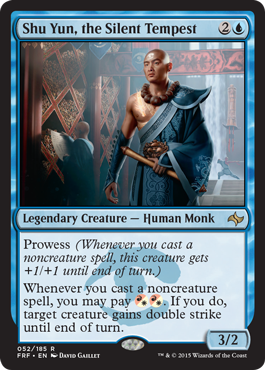
Shu Yun, the Silent Tempest
1 Month: Bulk
Dragons of Tarkir: Bulk
Why am I writing about Shu Yun if I think he’s bulk all the way down? Far and away the most probable path is that he’s $.25, but I’d be doing you a disservice if I ignored the possibility that Shu Yun could actually be disgusting. A Shu Yun on T3 sets up a T4 Titan’s Strength, Aqueous Form for sixteen unblockable damage. Even when you aren’t living the dream, he can output some insane damage pretty quickly.
Will it be good enough for Standard? I doubt it. Anything is possible though, and the potential damage output on this card is real.
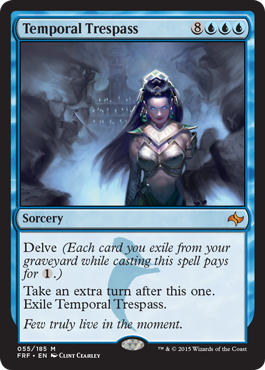
Temporal Trespass
1 Month: $2-$3
Dragons of Tarkir: $1-$2
We got a delve Ancestral Recall in Khans, and now we’re getting a (sort of) delve Time Walk in Fate Reforged. Are we getting a delve Timetwister in Dragons of Tarkir? Maybe even a 6cmc artifact delve Black Lotus? With contraptions??
As an overall community, we undervalued delve across the board. When Treasure Cruise was spoiled people weren’t quite sure if it was busted in half or if it was Shared Discovery. It took some actual games being played (and Jeskai Ascendancy casting it on turn two) before it became clear it was the real deal. Dig Through Time similarly was underrated.
I don’t think Temporal Trespass is on the same level as either Cruise or DTT. First of all, it costs more to cast than both, no matter what. Not only is the CMC higher than the other two, UUU is no small hoop to jump through. Once you’re trying to cast CCC spells, an overwhelming majority of your lands need to tap for that color. This means no “splashing” Trespass – it’s only going to fit in Cryptic Command manabases.
Another issue is that your graveyard is a finite resource, and two pieces of serious competition were printed in the last set that eat from the same plate. Extra turns are obscene in EDH, but in most other formats, Ancestral Recall is probably better than Time Walk. We only need to look at Temporal Mastery’s limited success to see that. Even Miracles, the deck best situated to take advantage Temporal Mastery, doesn’t run it. It’s possible that Temporal Trespass ends up in a combo deck somewhere – the eleven mana converted mana cost may actually help with that in some ways – but I think it’s likely this doesn’t manage to break into any of the three major formats in a meaningful way.
One alternate future timeline for this is one in which Treasure Cruise and DTT get banned in some number of formats. Trespass suddenly looks a lot more desirable when it’s the only thing vacuuming up your graveyard. I don’t think this outcome is likely, but I’d be remiss to ignore it.
For the Travis Woos out there, this does give Narset a Time Walk effect in Standard. Worth being aware of at least. If that somehow is good enough, Narset is probably the best target in the deck.
All things considered, we shouldn’t entirely discount Trespass. Temporal Mastery has climbed 50% since its low a little over a year ago, and I wouldn’t be surprised to see it break $10 in the not-too-distant future. Time Walk effects are always popular with a particular subset, and this one should be no different. Once this drops towards the $1 range it will be a solid pickup for long-term growth. As for the foils, well, I’ll let this price graph of the Temporal Mastery foil do all the talking.

Torrent Elemental
1 Month: $2-$4
Dragons of Tarkir: $2-$4
What an odd card. Every aspect of this feels a bit…forced. The power and toughness seem custom built to answer the format. Three power sneaks in under Elspeth’s board wipe, and five toughness means it can block a Siege Rhino. The attack trigger stops token decks from chump blocking you into oblivion. Is this just designed to fill every hole in the set?
Torrent Elemental is watermarked as a Sultai card, which the activated ability certainly reinforces. The idea here is that you delve away Torrent while casting Treasure Cruise or Tasigur, and then you can still put it back into play afterwards. I guess the question is whether that’s something people actually want to spend cards and mana on.
Looking at Misthollow Griffin, I see that there’s little casual demand for the “cast from exile” mechanic. Griffin is under $1, so I don’t think Torrent is going to be earning a price tag from the casual market. If this card is worth anything, it will be from the competitive scene.
I can certainly see a world in which Delve and self-mill decks are happy to play a few of these. Two copies are “free,” insomuch as any card taking a spot in your sixty is “free.” Flipping this over with Satyr Wayfinder and eating it with Tasigur is basically all upside, since once you Delve Torrent you’ve effectively drawn it. That’s pretty juicy, as virtual draw effects are always welcome, but do we care about drawing a 3/5 that taps things when it attacks? I’m honestly not sure.
SCG is sold out at $2, and eBay is finishing around $3 a copy. I think that is a pretty fair price, and could easily turn out to be way under market. Bulk mythics are typically in the $1-$3 range, so even if Torrent is a complete flop you don’t stand to lose much. The upside is double digits, although that’s a long ways from $2.
I can’t fault you for picking up a playset at prerelease weekend so long as you can get them for $3. The risk is tiny and there’s real upside. After a playset I’m not a buyer, but I am a keen watcher. A card like Alesha will go from $.50 to $5.00 in a single event, but Torrent elemental is the type of card that will keep showing up as a two-of in various decks for multiple weeks, adding a little bit of value to it’s price tag each time. Watch for results, and if it’s making waves on the SCG circuit, don’t hesitate to buy in at $2.
Black
Bulk
Archfiend of Depravity
Mardu Strike Leader
Palace Siege
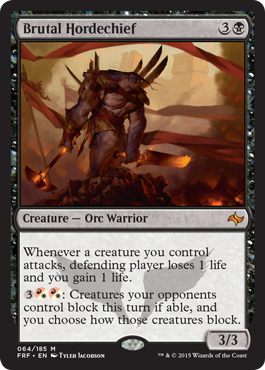
Brutal Hordechief
1 Month: $2-$4
Dragons of Tarkir: $2-$8
Brutal Hordechief is pretty aptly named, and I’m not the only one who thinks so. Hellrider showed us just how strong that drain on attack can be, and Hordechief makes the trigger even better by adding some lifelink just to be sure that racing is going to be a nightmare. Resolving Hordechief on T4 and immediately swinging with three tokens bolts your opponent immediately, and still has them facing down three more damage. The very next turn you can start activating Hordechief to force them into using all their dudes to block a 1/1 while you swing in for 7-8+ damage. If you swing with three tokens along with Hordechief while making all their guys block a single token, they take nine damage. It adds up fast!
There are admittedly distinct differences between Hordechief and Hellrider. Part of what made Hellrider so dangerous was that he had haste, often killing the opponent outright or putting them within range of a Lightning Strike the next turn. Hordechief is slower, and lacks the ability to put the game away on the spot. Hordechief isn’t as fast, but he is a little stronger as the game goes longer.
Where Hordechief lacks haste, he has the secret ability to protect himself. Hellrider may have had haste, but if your opponent had a few blockers, you couldn’t swing without fear of losing him. There were times where Hellrider had to stay at home to avoid dying in combat. Hordechief’s activated ability not only allows you to alpha strike the snot out of your opponent’s face, but in situations where you can’t kill them outright, it means that you can attack with impunity. Just make sure nothing blocks Hordechief and you get to do it again next turn. Where Hellrider had haste, Hordechief has the ability to attack at will and never fear dying in combat.
Remember as well that even if Hordechief is strictly worse than Hellrider, that doesn’t actually matter – Hordechief isn’t competing against Hellrider, because Hellrider isn’t legal. There’s room for a card to be worse than Hellrider and still be a Standard staple.
He’s preordering in the $6-$10 range right now, which is where his price would be in the nearly-best-case scenario. What is much more reasonable is a price tag in the $3-$5 range. If after that he doesn’t manage to put up strong results expect him to fall towards bulk mythic. If tokens takes off in this direction and ends up Mardu, he could push back towards $10. I can’t say for sure which path he’ll take, but just watch tournament results and you’ll be able to see it coming.
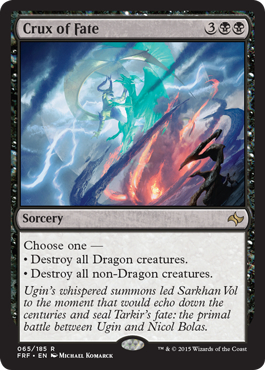
Crux of Fate
1 Month: $2-$3
Dragons of Tarkir: $1-$2 or $3-$6
Crux of Fate should do better than End Hostilities in both price and play because it’s much better positioned. UB is the de-facto control colors right now, for the first time since Sphinx’s Revelation was printed. With a control deck already in place and just waiting for this effect, the reception for Crux will be much warmer than it was for EH. Ugin being printed makes life even better for Crux, since UB control will be getting such a powerful card at the same time. Most expect UB control to be a serious player in the meta after Fate Reforged, and Crux is going to be a four-of in every list to start. It even has a not-so-secret Plague Wind mode just as icing on the cake.
People assume this is going to be the same price as Hostilities because they’re so similar. While that’s a possible outcome, I’m not convinced. I wouldn’t be surprised to see Crux live it’s life at two to three times more than EH, since the format is so much better positioned for a black sweeper than white, and because black gets castable sweepers so much less frequently.
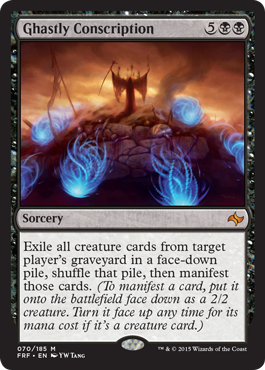
Ghastly Conscription
1 Month: Bulk
Dragons of Tarkir: Bulk
Unreliable in any constructed format, and not even great at what it does in EDH. Rise of the Dark Realms is just better.
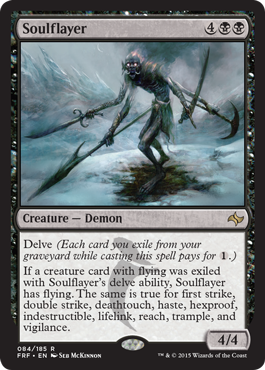
Soulflayer
1 Month: Bulk
Dragons of Tarkir: ???
$.10? $10? Nobody knows! Soulflayer is potentially one of the strongest cards in the set, but the setup necessary to get paid may not be worth it. There are some pretty powerful interactions in place in the format right now for him, that’s for sure. Pharika and Soulflayer may fast become friends, as Soulflayer eating Pharika gives you an indestructible 4/4, and Soulflayer provides double devotion for Pharika. If the pieces fall into place, “Soulflayer delving Chromanticore and Pharika” may be one of the most common and frustrating sentences spoken aloud at Standard events in the coming months. If it ends up being too difficult to reliably put together, it’s only a combo you’ll need to fear in the 1-2 bracket at FNM.
What I see as being the most important factor in Soulflayer’s success is how playable cards with those keywords will be independent of Soulflayer. Not having to jump through hoops to make him worth casting is the real trick. If there are keyworded cards that you’re happy to cast on their own, that makes Soulflayer a strong addition to a deck that’s already playable. If instead the format is all tokens, Siege Rhino, and Monastery Mentor, Soulflayer looks much worse. Either way, Soulflayer is not going to come out blazing.
Watch the Standard landscape to see what types of creatures are showing up. Do black decks have lots of keyworded threats? If so, then it may be time to move in on Soulflayer.
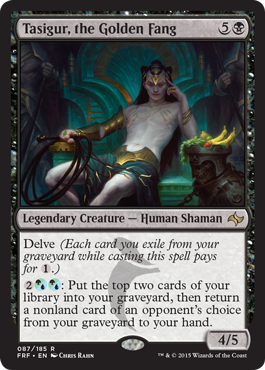
Tasigur, the Golden Fang
1 Month: $1-$3
Dragons of Tarkir: Bulk – $5+
Let’s start with this: Tasigur is possibly the best rare in the set. Three months with Treasure Cruise and DTT have made it crystal clear that delving three to seven cards can happen way sooner than you realize, even in Standard. With five in the graveyard Tasigur is a one-mana 4/5 that has “2CC: Draw a card” as an ability. To get a better picture of the strength of Tasigur, check out Sam’s article and Ari’s discussion of him as well.
What jumps out at me most while reading those descriptions of Tasigur is how many different types of decks can play him. He’ll be an almost automatic 2-of in Abzan decks out of the gate, which is a top-tier Standard deck and isn’t going anywhere. He also has a home in control shells as a stabilizer/finisher/card drawer. More aggressive decks looking to go under midrange can even find room for him as a way to play two spells early in the game and as a means to keep their hand full of pressure while trying to finish off an opponent.
When three distinct strategies all have an interest in a creature, that’s a big check mark in the plus column. Not only will he fit in multiple existing shells out of the gate, he’ll be a worthy candidate for nearly any deck that generates black mana in Standard in future. On that note, he’s only one color – another big check mark for price growth. One of the best ways for a card to dramatically increase its value potential is to be desirable in the eyes of multiple strategies and decks.
Beyond Standard, Tasigur looks even better. With Jeskai Ascendancy casting Cruise on turn two, we don’t have to wait long in eternal formats to resolve our first 4/5. Just crack a fetch and cast Thought Scour, and you can cast him on turn two. He’s a bit of a nonbo with Tarmogoyf, but that can be mitigated to an extent, and he’ll be able to fit in decks that may not be able to cast/support Tarmogoyf. Any black attrition shell should be interested in Tasigur as a way to earn extra value on all their spent discard/removal, and after delving away all the Thoughtseizes, Tasigur will keep recurring your removal.
I’m not blind to the similarity between Tasigur and Hooting Mandrills. Much is shared between the two cards. But just because they are similar, it does not mean they will see the same play, nor will they be the same price. While their colors are different, that’s mostly a wash. An extra point of toughness on Tasigur is a rather big deal – he survives Stoke the Flames and blocks Siege Rhino in Standard and 4/5 Goyfs in eternal formats. His activated ability is also quite relevant, as it basically says “draw a card.” That’s an awfully powerful ability, and if Hooting Mandrills had it, you better bet your butt that we’d be playing against Jungle Book.dec in Modern and Legacy.
Tasigur is legendary, which is a drawback, and he lacks trample as well. Both of those are fair concerns, but ultimately I don’t feel that they’re enough to offset what makes him better than Mandrills. The apes have been on the edge of playability since September, and my guess is that “draw a card” is enough to push them into multiple formats.
Where does this leave his price? If he was mythic, this would be a much easier guess. As a rare it’s more difficult to figure out. With so many mythics looking like they will have a real presence in Standard, this set could end up with a lot of pricey red rarity symbols. If we get a set where five or more mythics are Standard role-players, rare prices will be suppressed. If only one or two mythics end up breaking through, then Tasigur’s ceiling will be much higher. Keep in mind too that the fetchlands will be floating around in FRF packs, which doesn’t help, although I don’t believe the supply large enough to be particularly impactful.
It’s unlikely that Tasigur jumps from his preorder price out of the gate, although I don’t expect it to fall much/at all. Early success will push him up into the $3-$5 range, and if it’s consistent, that price will solidify/rise slightly. With Siege Rhino in the same $3-$5 range it’s tough to imagine Tasigur rising above that, but he could easily keep pace with Rhino. If he ends up being one of the best three cards of the set – which is entirely possible – he may reach double digits. Rhino probably already would have if not for the fetchlands.
Even if he doesn’t breakout immediately and sinks towards bulkish, he’ll be a great pickup over the summer. Until then, this is one of the few cards I picked up for myself at preorder prices.
Red
Bulk
Arcbond
Flamerush Rider
Outpost Siege
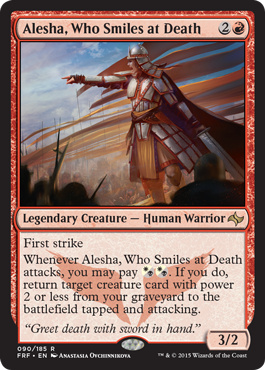
Alesha, Who Smiles at Death
1 Month: $1-$3
Dragons of Tarkir: $1 or $3-$5+
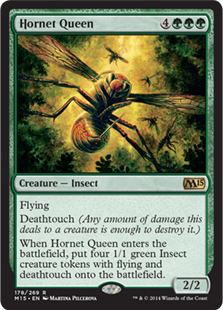
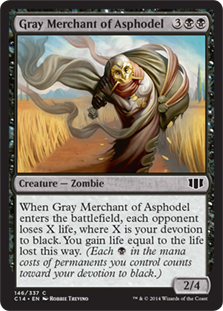
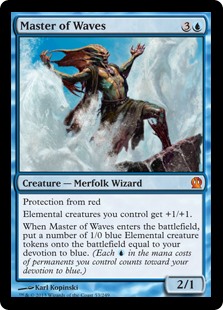
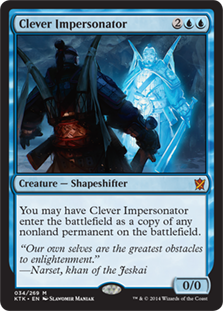
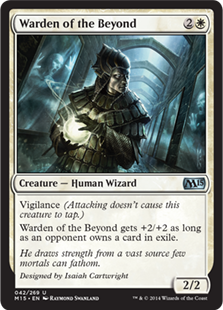
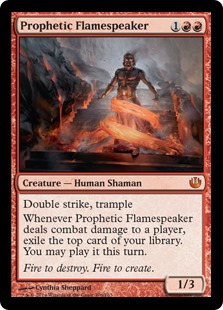
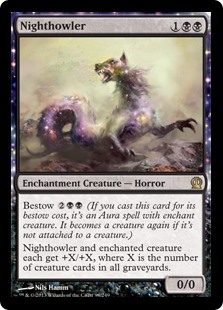
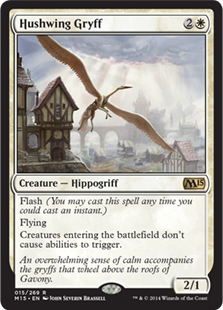
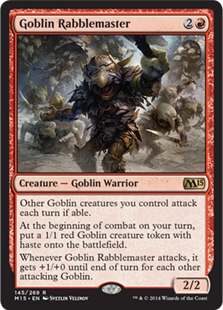


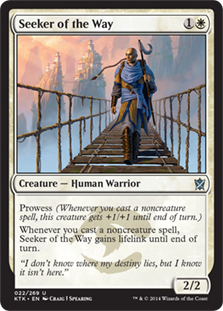
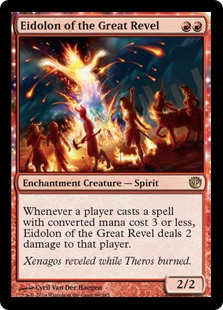

Daghatar the Adamant
Monastery Mentor
Battle Brawler
From Jund reanimator returning Hornet Queen to midrange returning Courser or Rabblemaster or Monastery Mentor to aggro returning Eidolon or Swiftspear or Battle Brawler, there are a variety of shells in a variety of colors that would be more than happy to pay Alesha’s trigger. Level zero is using it alongside Whip to get back Hornet Queens in a more aggressive reanimator deck, but there’s no shortage of options. I’m sure if I looked into Modern targets there’s some even more busted options. (Gigantomancer? Trostani’s Summoner? Sutured Ghoul?)
2R for a 3/2 first striker isn’t a bad rate, and the amount of hell she brings with her pushes her over the top. Attacking straight into Courser is a bit frustrating, but if you can set up triggers that either pump her past Courser or make dying to it irrelevant, you’ve more than gotten your money’s worth. If Tasigur is the best rare in the set, Alesha looks like she may be making a run for second or third. Then again, I’m a sucker for a good cheaty card.
Alesha is preordering for $3-$4, which means that the hype isn’t too big. It sounds like she’ll slip into Standard without a lot of fanfare, and without immediate results she’ll drop in price quickly. Within two or three weeks I wouldn’t be surprised to see her hanging around at about $1. Don’t think this means she missed the boat though – this is exactly the type of card that people forget about until it wins a GP and suddenly jumps in price.
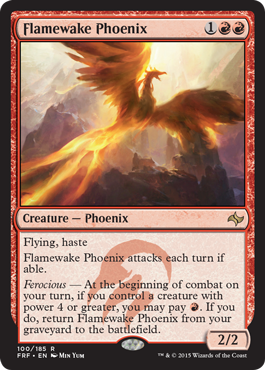
Flamewake Phoenix
1 Month: $2-$4
Dragons of Tarkir: $2-$4
Flamewake is legit. Three for a 2/2 flying haste is riiiight there, and with the number of great four power creatures in the format, he’s got no shortage of fuel. Without even leaving red there’s Shaman of the Great Hunt and Ashcloud Phoenix. If you’re willing to branch out there’s Butcher of the Horde, who will just keep eating the phoenix for repeatable vigilance and lifelink. I’m sure I won’t be the only one to be completely sick of this card within a few months.
Flamewake is already preordering for around $5, which isn’t far from the ceiling on a card like this. Even if it sees about as much play as it reasonably could I wouldn’t expect the price to be more than that. What we’re likely to see is the price float around in the few dollars region for quite some time, with only small variations within that window.
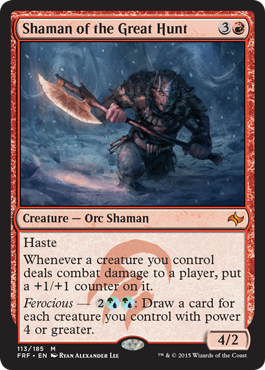
Shaman of the Great Hunt
1 Month: $3-$5
Dragons of Tarkir: $2-$7+
Most reception to Shaman is positive, and for good reason. Haste is easily one of the best keywords, and on a four-power attacker it’s extremely threatening. Many premier hasty finishers are often in that ballpark – think Stormbreath Dragon and Thundermaw Hellkite. His secondary ability means he grows out of control almost immediately if you let him connect just once, and even if he gets blocked the other guys you swing with will get to grow.
His ferocious trigger is great, especially when you consider how many four power options there are floating around. Savage Knuckleblade and Yasova both come down ahead of Shaman and give you additional ferocious power. Shaman having four himself also means that he enables Flamewake Phoenix, another strong hasty red card.
I’m sure you’ll be reading more about Shaman from strategy writers in the future, so I won’t dwell on his strength. He’s legit, which is what we’re concerned with. I don’t expect his price to dip much at all within the first few weeks after release. If nobody is able to find him a home he may slip below $3, but I think we’re more likely to see Kibler slinging a full set somewhere right along and that will prop him up at least around $5. A price tag of $5-$8 is reasonable, and above $8 is plausible, although that puts him as the second-strongest mythic or so in the set. Both $5 and $15 are potential price points for this guy, depending on how the format breaks.
Green
Bulk
Frontier Siege
Sandsteppe Mastodon
Shamanic Revelation
Temur War Shaman
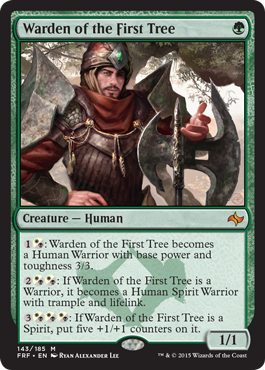
Warden of the First Tree
1 Month: $3-$6
Dragons of Tarkir: Bulk Mythic
Warden of the First Tree is my vote for the most overrated mythic in the set. When Figure of Destiny was first spoiled, people hadn’t figured it out yet. Turns out the card was amazing, and everyone remembers that. Now that Warden comes along, people want to make sure they “get” him before he breaks out.
Warden of the First Tree is not Figure of Destiny. I really like how Ari said it, so I’m going to quote him:
“Figure of Destiny was a 4/4 in a format of Agony Warp and Firespout.
Warden of the First Tree is a 3/3 in a format of Courser of Kruphix, Siege Rhino, and Lightning Strike.”
Figure let you swing for two on turn two while either playing something else that costs one or a tapped land. Warden requires two mana to hit his second level, which means that in order to activate him on curve you’re taking a lot of damage from lands and postponing dropping a tapped land until later turns.
Where the cards really diverge is on the second activation. Not only does Figure’s fire a turn earlier, he ends up as a 4/4, while Warden is a 3/3 with useful abilities. There are definitely formats where a 3/3 lifelink trample is better than a 4/4, but a format with Courser of Kruphix and Siege Rhino is not one of them. Let’s try comparing their total mana costs through the second activation. After five mana, Figure of Destiny is a 4/4. That’s a limited quality creature, for sure, but it’s not heinous. Warden is a seven mana 3/3 lifelink trample. That is a lot worse than a five mana 4/4.
Warden’s last ability pays you each time you activate it, where Figure’s will not. However, you can’t expect to activate the final level frequently. There’s some low percentage of games where you’ll be able to make him an 8/8 lifelink trample, but the number of games where you lose with an 8/8 lifelink trample but win with a 13/13 lifelink trample is absolutely tiny.
Perhaps the format eventually changes to make Warden useful. It’s possible. I think Courser has to rotate before we get to that point though, and even that may not do it when cards like Siege Rhino and Savage Knuckleblade are floating around.
Preorders are in the $10 range, and it’s not going to plummet immediately. A month from now he may still be $5, but I expect him to be near bulk mythic by the time Dragons of Tarkir releases.

Whisperwood Elemental
1 Month: $3-$5
Dragons of Tarkir: $3 or $15
Whisperwood Elemental, and every card with the keyword manifest, is sort of an unknown right now. Technically, we know what manifest does. It flips a card face down onto the table as a 2/2, and you can unmorph it if it’s a creature. (Non-creature manifests can’t be unmorphed ever.) Like many mechanics before it, it’s going to take some table time to figure out just how useful the ability is. How often do we actually hit creatures? Do we care? How good is unmorphing stuff? Are any of the wombo combos with manifest, such as Hooded Hydra, good enough to matter? I have a sneaking suspicion that manifest is going to end up being strong when you aren’t overpaying for it.
Our first tool for understanding Whisperwood is Master of the Wild Hunt. Both are an X/X for X+1 that make a 2/2 each turn. Huntmaster comes down a turn earlier, but you actually end up with the token about the same time as you do with Whisperwood. If you cast Master of the Wild Hunt on turn four, you don’t get the token until the upkeep of your fifth turn. If you cast Whisperwood on turn five, you get the 2/2 at the end of your turn. Master gives you the token at the beginning of your fifth turn, and Whisperwood gives it to you at the end of your fifth turn. Since neither can attack that turn, they’re very nearly the same thing from a “vanilla 2/2” standpoint. In fact, your opponent has a longer window of time in which to answer the Master before he gives you a wolf token than they do to answer the Whisperwood.
Where Master was pseudo-removal, Whisperwood has Wrath protection. He essentially has “screw your sweeper” written on him. They sweep, you sac, and now you have several manifests in play when you untap. Sweeper protection on a strong green threat is greatly appreciated, since the type of deck to play Whisperwood is exactly the type of deck that can and will lose to a resolved Crux of Fate. Whisperwood allows you to overcommit to the board and begins generating value immediately. Not only does Whisperwood let you fearlessly play him into a board where you already control several creatures against a wrath deck, he also means that you don’t need to cast more threats after either. Just let him keep making his manifests, and unmorph those as you go. Your pressure continues to build without needing to put more cards into play.
Let’s talk about manifest for a minute. You see, manifest is sort of like drawing a card every turn. About one half to two-thirds of the time, the card you draw is a free 2/2, which isn’t bad. The rest of the time you draw a free morph. Whenever you manifest a real creature, you get to “cast” that creature for its unmorph cost. Manifesting Polukranos is just like drawing him, except until you cast him, he’s a 2/2 instead of a card in your hand. Drawing a free card every turn in a green deck is just going to be so strong against so many opponents. Against non-sweeper decks Whisperwood is pure gas. If he only made a 2/2 token every turn he’d be good enough, but making manifests is even better. The fact that he protects against blowouts at the same time is just gravy.
Whisperwood is preordering for about $5 right now, which is pretty close to bulk mythic as it is. If he saw absolutely zero play in Standard, he’d still be about $2-$3, right? He doesn’t have far to drop right now. Worst case scenario is that he loses $2 from where he is. What’s the best case scenario though? The best case is that he ends up being a major standard role-player, and any deck that makes green mana wants some number of copies. If that’s the case, he’s easily $5-$9, and possibly even double digits if he’s a real contender. Imagine he sees just as much play as Polukranos has. Polukranos has floated between $5 and $15 since release, and he’s both a fall set mythic AND is in a duel deck. That duel deck absolutely suppressed his price. Without that additional printing Polukranos easily would have been over $20 at one point.
At this point, Whisperwood has my vote for the most underrated mythic in the set. I’m not buying any copies today, but I’ll be picking up a set as soon as the preorder prices start coming down. I’m not guaranteeing you that Whisperwood is going to rise in price, but he’s very near his floor today, and the ceiling is over $20.
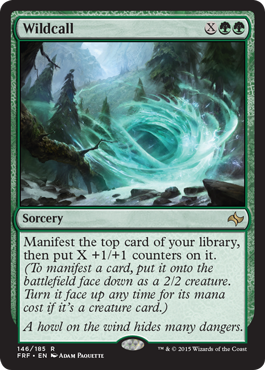
Wildcall
1 Month: Bulk – $2
Dragons of Tarkir – Bulk – $5
Wildcall is certainly a flexible card, which is always appreciated. Flexible cards are always in the running for being playable, even when you’re overpaying for any specific mode. Think of Wildcall as a modal spell, except it has an actual infinite number of modes. GG for a 2/2, or 1GG for a 3/3, or 2GG for a 4/4, and so on and so on. Is GG for a 2/2 exciting? No, of course not. Nor is 3GG for a 5/5. But having the option at any point in the game is certainly worth something. It can play the bottom of your curve if you draw a grip full of 3’s and 4’s, and it can play the top end if you draw a bunch of mana dorks.
If Wildcall just made a creature token, it may or may not be playable. We get more than just the token though, we get the face down card. A large portion of time it really will be a token – we’ll flip a land or a spell. When it’s a creature though, we really get paid. Not only do we get our X/X for X, at some point later we get to unmorph and have a real creature that now has a bunch of counters on it. The dream is unmorphing Hooded Hydra for GG, but even normal threats will be absolutely fine. Rattleclaw Mystics give you the option of a mana explosion, and creatures with trample or double strike could just kill the opponent out on the spot if they block wrong.
Wildcall will never be expensive, but it does have the chance to be a Standard role-player and earn itself a price tag of more than a dollar or two. If either Wildcall or Whisperwood starts showing up in lists, then the other is probably not far behind.
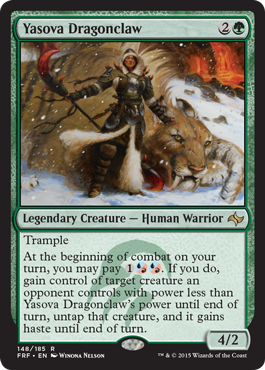
Yasova Dragonclaw
1 Month: Bulk – $2
Dragons of Tarkir: Bulk – $3
Yasova feels close to being there, but isn’t quite. Her stats match up poorly against Courser, which admittedly is true for Shaman as well, but he only has to sneak by once to start crashing through. Yasova is going to run into that problem repeatedly. She’s also brick walled by Siege Rhinos all day long.
Even though she’s only got two toughness, four power is a beating. And at three mana, she’s a potential turn two play off a Mystic. You also don’t need to attack with her to use her trigger, which means you can keep stealing and swinging with their threats without exposing her to danger.
The real trick will be finding a way to pump her power. Shaman is a start, and we should be on the lookout for other strong ways to do it. Xenagod is certainly an option, which not only opens up the door to stealing Rhinos, but just about anything in the format. Xenagod also happens to play beautifully with the new Gruul dragon, so maybe there resurgence of big Gruul beats is just around the corner.
I’m thinking she probably spends most of her time in the bulk to $1 range, but if enough power-pumping support ends up being playable, she could be a few bucks.
Multicolor/Colorless
Bulk
Crucible of the Spirit Dragon
Scroll of the Masters
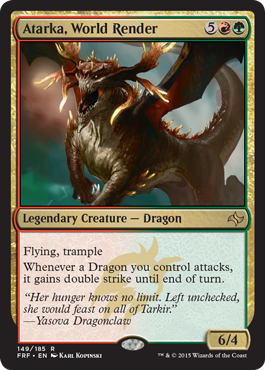
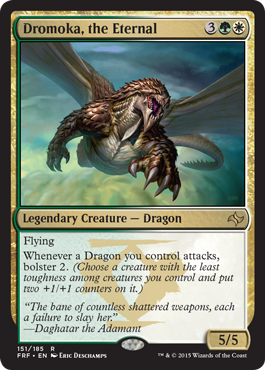
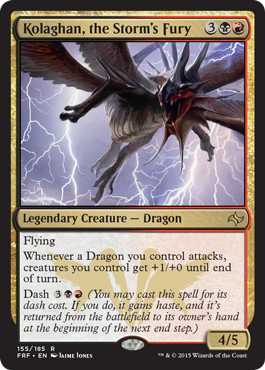
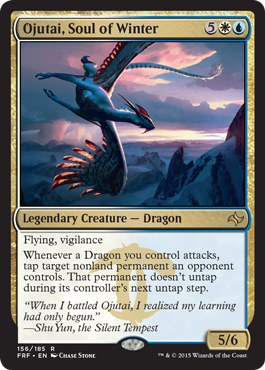
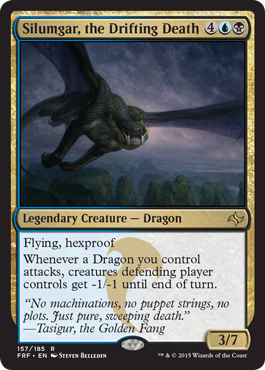
Dragon Cycle
1 Month: $1-$2
Dragons of Tarkir: Bulk – $2
The Gruul, Dimir, and Rakdos dragons should make occasional appearances in Standard over the next year or so. Xenagod combines with the Gruul dragon to kill in one hit, the Dimir dragon eats Elspeth alive and massacres the increasingly-powerful token theme, and the Rakdos dragon plays well with Frontier Siege and token strategies.
Even though three of the five have slots to fill in Standard, I don’t expect any of them to see enough play to warrant price tags above a dollar or two. They’re all curve-toppers and unlikely to be worth four slots even in their best decks. Casual demand will keep their value from bottoming out too low, but I don’t expect any of these to break $3 before Dragons of Tarkir. DOT will dictate whether these become more playable. I doubt we’re going to see two and three drop dragons, but if we do, then there’s the chance these guys become much better positioned. Those attack triggers get fearsome quickly when you can activate them more than once a turn.
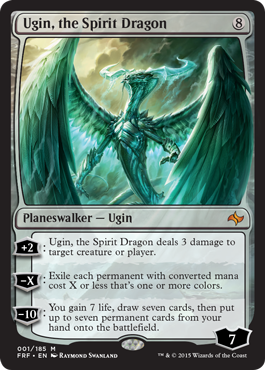
Ugin, the Spirit Dragon
1 Month: $25-$30
Dragons of Tarkir: $18-$25
Ugin is damn strong. Pat and Ari each wrote articles about him, as I’m sure many other strategy writers have and will. The long and short of it is that Ugin will show up lots of places.
In Standard, Ugin will be an important role-player. Even though he isn’t going to be a 4x in many decks, he’ll do a lot to make UB control more viable. UB hasn’t had a really solid finisher up until this point, and it’s had to rely on Perilous Vault to do it’s cleanup work. Ugin handling both of those roles is huge. That will in turn change the way the format plays out, so even operating as only a two-of in a single deck, he’ll manage to change the entire format. There’s a chance he could show up as a full set in green devotion or something, but I’m not counting on that.
Modern Tron will definitely be interested in a few copies. People are quick to compare him to Karn or Oblivion Stone. Yes, he comes down slower than Karn, and yes, he doesn’t do certain things that O-Stone does. What is being missed here is that while he’s not exactly Karn and he’s not exactly Stone, he does a damn good impression of them at the same time. Not only can he come down and clear the board like Stone will, he’ll also start zapping creatures/faces and moving towards a victory. Like a modal spell, while he may not do either half quite as efficiently as would be done on it’s own, the fact that he offers two halves in one card will be very important.
MUD decks in Legacy will surely be happy to have some number of Ugins, as not only will he wipe all sorts of problematic permanents (including TNN), he’ll leave your own artifacts alone. I’m not sure how many not-MUD decks will be interested in him, but I imagine at least one or two will be.
That he’s colorless means he’s an option for every single EDH deck, and given how amazing Pernicious Deed effects are in that format, I assume he’ll be adopted by many lists. We’ve never really had a Planeswalker with such universal EDH appeal so it will be interesting to see how much extra demand this generates. It will certainly drive the foils higher.
As if playability in Standard, Modern, Legacy, and EDH wasn’t enough, he’s also very cool. He checks a lot of boxes for casual players, even the dragon checkbox. (Sort of.) Planeswalkers have always been popular with the kitchen table crowd, and Ugin will be more so than most.
It seems the planets are aligning to make Ugin a valuable and sought-after Planeswalker. He’s fetching around $30 right now, and we won’t see that dip much within the first month. By the time Dragons comes out it will have dropped a bit, but I’m not even sure he’ll be under $20. I suppose eventually he will be under $20, but I’m not sure how long it will take, and without a reprint, it will be short lived. Once he bottoms out, perhaps next July, he’ll start rising and won’t stop until either $50 or a reprint.
Starcity released the foil at $80, and I don’t think that’s too far off the mark. Foil Planeswalkers are always expensive and EDH/eternal demand will help push that envelope even harder. It looks like foil Karn was at his lowest the fall after he released, so that may be the time to see how Ugin is trending. Other Planeswalkers have different foil trajectories, but many are tied closely to Standard success and reprints. Karn seems like the best approximation here.

One last note on Ugin: apparently there’s an alternate art version that will show up occasionally in the prerelease packs. I’m not sure what the foil situation is. In any case, any alt-art foil Ugins will be worth more money than anyone wants to have to admit they spent on a Magic card, and they will probably never be cheaper than whatever their price will be a few days after the prerelease.
